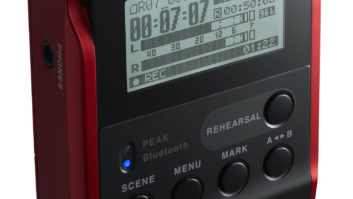
Audio-Technica AT2020 USB Unless you’ve been under the radio broadcasting rock, you probably are aware that microphones that use a USB (Universal Serial Bus) connector are a hot item from microphone makers these days. Everyone from Audio-Technica and Shure to MXL and Samson are joining the USB bandwagon.
And make no mistake, USB microphones are not a fad. If anything there will be more of them and they are migrating from the lower end towards the higher end.
44.1 kHz limitation
At the current time, USB microphones are occupying the lower rung of quality, so to say. The typical “USB audio” chip is a 16-bit/44.1 kHz kitten, not a 24-bit/96 kHz lion. These chips were developed as a cheap, universal audio input source for use with computers. Laptop “on the road” usage has proven especially popular. Podcasts and similar programming were the content targets, along with users of inexpensive Garage Band-style music production software.

MXL Microphones 009 While this USB audio quality is nominally “CD quality,” quality was not as important as simply having an audio signal. And the lower bandwidth specs for Internet audio were and still are relatively undemanding.
Michael Goodman, managing director of CEntrance, the maker of the MicPort Pro USB interface, is blunt: “USB mics currently on the market use the quality-limited 16-bit/44.1 kHz chip, designed originally for computer audio headsets. The audio quality therefore is insufficient for pro audio applications and that’s why USB mics have not yet caught on for professional use.”
Al Peterson, production director at program syndicator Radio America and RW contributor, said: “USB mics are great when you need to digitize directly to a laptop without a dedicated interface. But a lot of radio audio producers in the field don’t want to jeopardize an expensive computer much less a condenser mic [with a USB adapter] — both relatively fragile items.”
But as with all things involving computer technology, things improve quickly (and often the price goes down). Computer chip designers are building commoditized (re: cheap) native 24-bit/96 kHz chips and microphone manufacturers are taking advantage of them.

CEntrance MicPort Pro And now that broadcast ENG operators run around armed with laptops, audio quality has become a rightful concern. USB mics are an especially interesting idea for broadcast ENG users and producers/talent on the road. The USB part of the mic carries the preamp so a separate preamp (or mini mixer or DAC) becomes unnecessary, saving valuable space and weight in the kit.
Also, the USB cable tends to be lighter than the traditional XLT cable. The downside is that the USB cable is less durable and the connector tends to slide out of the computer far easier than the sometimes locking XLR connector slips out of its mate.
Plug and play
USB mics also try to be easy to use. Their “plug and play” specification means that they should plug into any computer (of relatively recent vintage) and be immediately recognized. Many USB mics ship in “packages.” Sometimes these packages include simple or “lite” versions of popular DAW or recording software. Some even include a mic stand. Sometimes these mic stands are more than toy stands and actually function properly — a clear indication that mic manufacturers are moving them into the professional market.

Shure recently launched the PG27 and PG42 as traditional wired mics and USB mics at the same time. Steve Savanyu of Audio-Technica summed it up: “The biggest advantage to a USB mic is plug-and-play simplicity. The user does not require external sound cards, or other gear to get audio into the computer. A decent USB mic and a laptop allows a VO artist, podcaster, reporter or field correspondent to produce quality audio anywhere. I know several VO artists who carry an [Audio-Technica] AT2020 USB along with their laptop when they travel.”
Still, not all is perfect. Savanyu said: “One of the issues with a USB mic or any A-to-D conversion device is latency. For field acquisition, podcasts and most VO, this is probably not an issue. However I think in a live studio broadcast application it might be a problem due to the need for talent to monitor the audio in real time.”
He also pointed out the complexities of a USB future in the studio: “A second issue is dealing with multiple microphones and mixing. Typically a computer can support a single audio interface (in this case a single USB mic). Most air studios have several mics that need to be controlled and mixed for the broadcast. However, I can see USB mics being used in off-air production studios, VO booths and other production related broadcast applications.”
As IP-based audio, another current rage, becomes a more common and familiar practice USB mics might start appearing in broadcast studios. But for now no one is planning on the RE20 USB. The USB microphone’s immediate future is at the lower and busier end.
That of course doesn’t mean that the USB microphones are condemned to drudgery. Recently, MXL Microphones’ .009 seems to have claimed the title of first 24-bit/96 kHz USB mic on the market. And in researching this piece several microphone makers indicated that they too have 24/96 USB mics in the wings.
Adapters
Also not to be forgotten are USB “plug-on,” “plug-in” or “in-line” adapters. These handy widgets, some modeled on wireless microphone plug-on adapters, some mimicking USB thumb drives, allow almost any standard phantom-powered microphone with an XLR connection to be turned into a USB microphone. The USB adapter contains preamp and digital audio conversion circuitry along with its USB tools making for an all-in-one connection to a DAW. And making use of the current, familiar microphone collection is always a money-saving option.

Goodman said of his product: “Our MicPort Pro customers are professional broadcasters, musicians, recording engineers and voice-over artists. They usually have a collection of mics, each unique in its sonic character … The MicPort Pro features true 48V phantom and adapts easily to any microphone, including condenser and ribbon mics.”
Blue Mics and MXL have USB adapters and Shure is launching one soon.
MXL currently has the largest selection. According to Mike Descher at MXL: “We make not just one, but four different types for specific uses. The MicMate Classic is for condenser microphones. The MicMate Dynamic is for dynamic microphones. The MicMate Line Level is for line-level devices, and the MicMate Pro is for the individual who needs flexibility, infinite gain control and headphone monitoring.”
The adapters face the same 44.1 kHz problem as the mics but that is changing. Goodman points out that: “CEntrance is the only company that offers a 24-bit/96 kHz chip transforming any mic into a professional 24/96 USB recording studio. Our solution takes full advantage of the low noise and full bandwidth of the expensive cartridge inside the mic, without losing quality in the A/D conversion process.”
The CEntrance MicPort Pro also has gain and headphone controls. Expect such features to become the norm within the year.
USB microphones have a bright future in many ways. Thinking further along the line, the plug-and-play aspect of the USB mic would allow mobile talent to use a laptop to connect directly to a studio — obviating a need for a traditional codec (and all the problems with that). Anyone who is watching the proliferation of “IP” codecs can get a whiff of the future fire.
In talking with several veteran Radio World writers, professionals at radio stations, most expressed a skepticism of current USB microphones but, and it’s a big but, they were also extremely curious and following development closely — especially for use with ENG reporters and with mobile kits.












